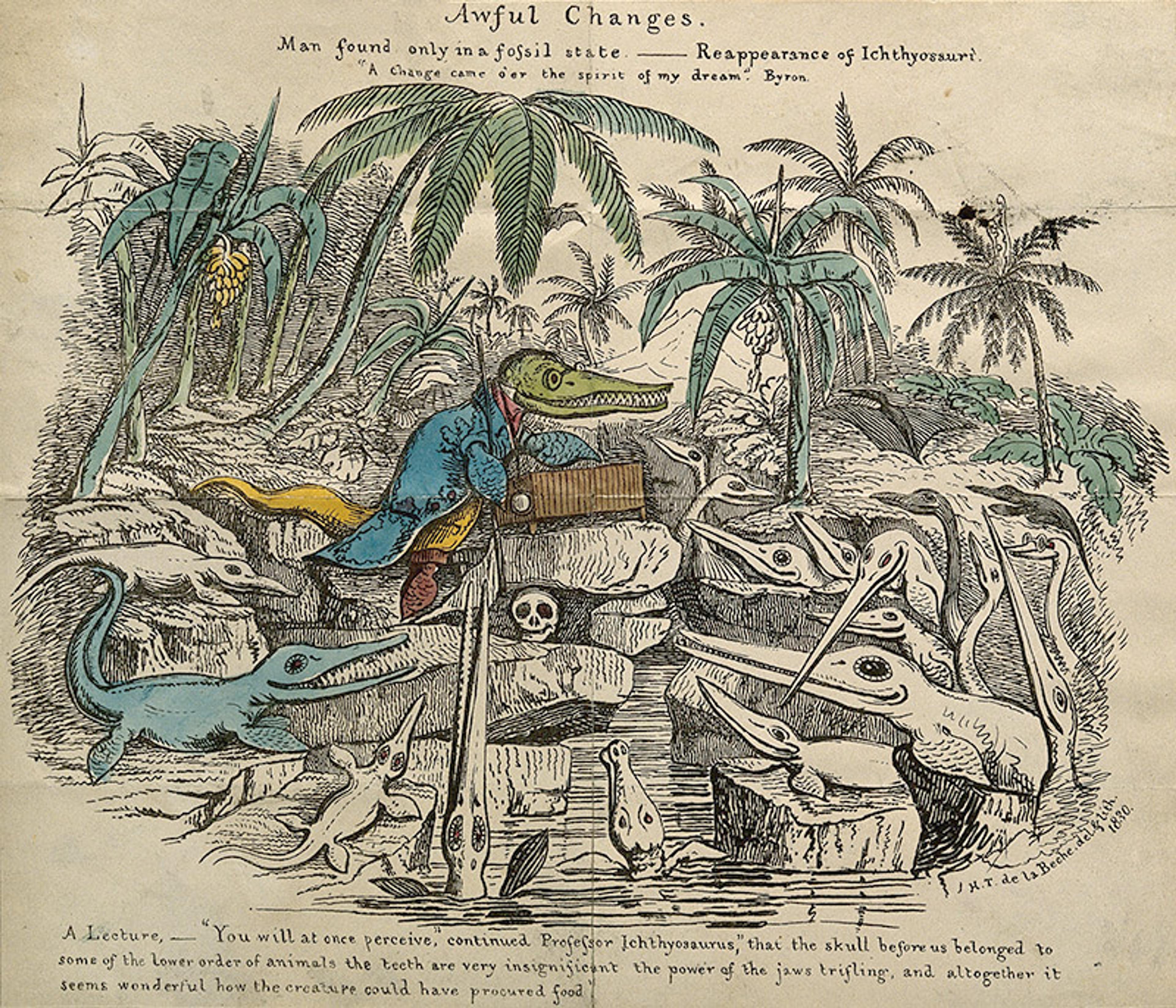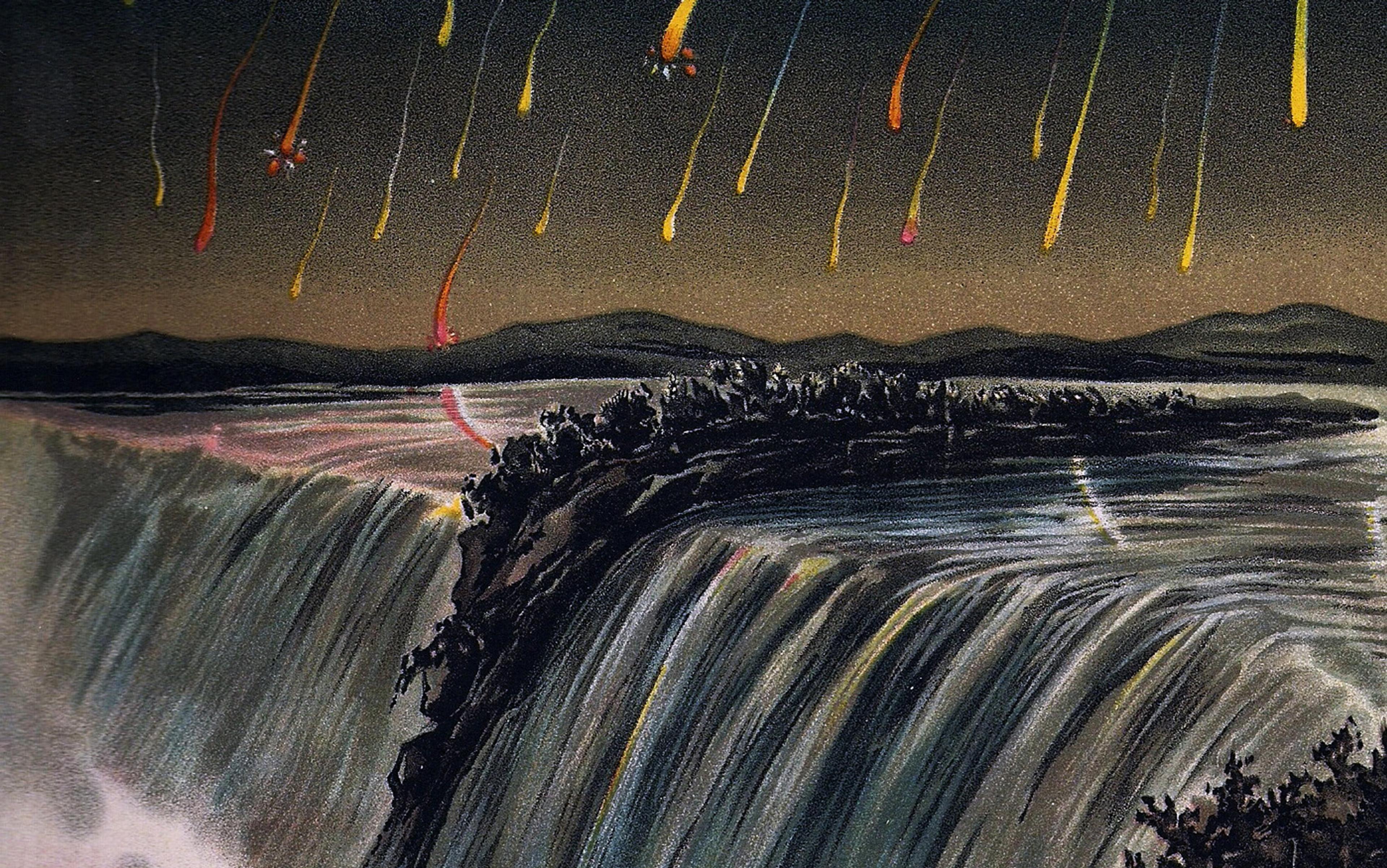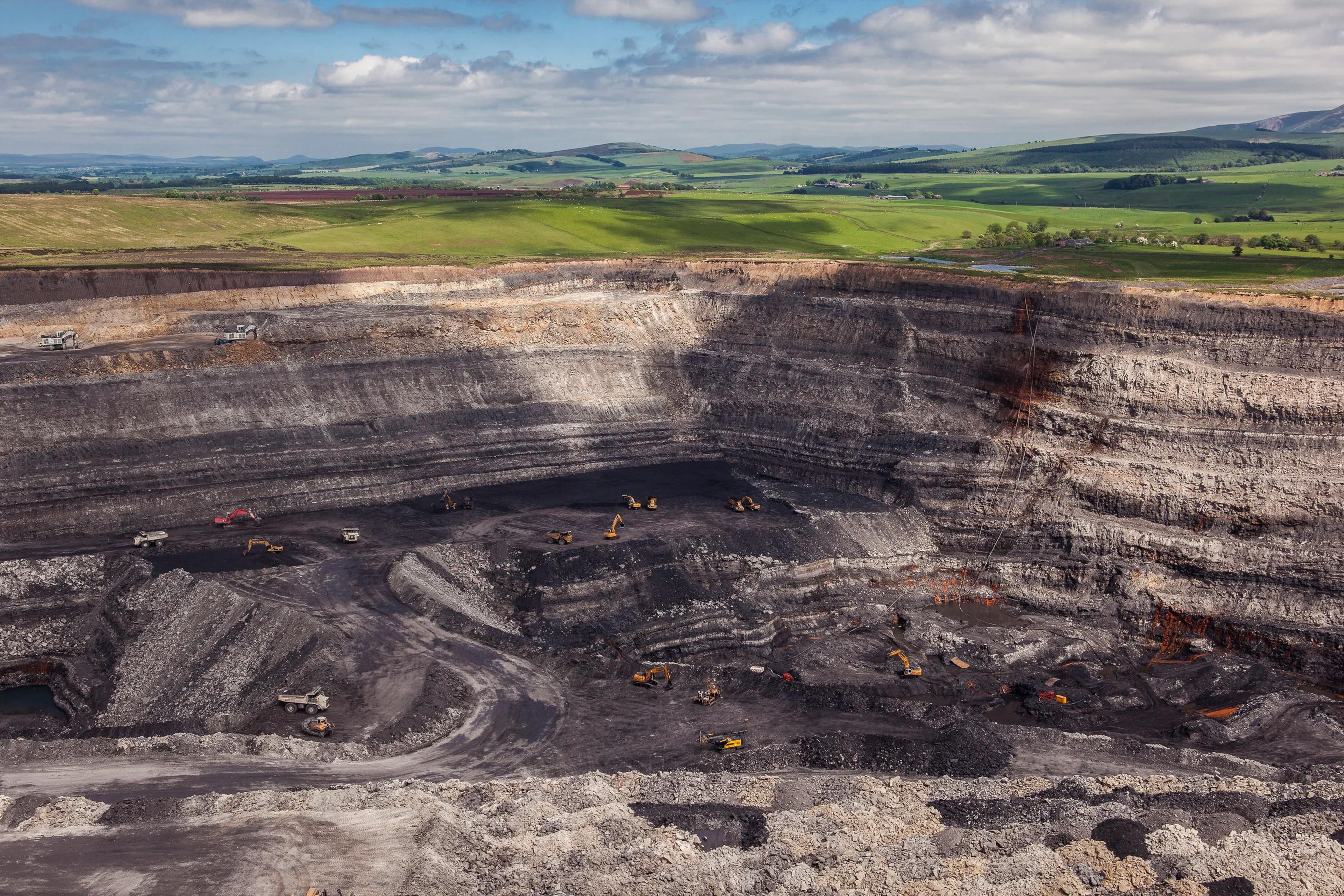In 1844, the Russian prince Vladimir Odoevsky wrote a short story in which a future humanity, stricken with overpopulation and resource-depletion, welcomes a ‘Last Messiah’ who instructs a jaded mankind to commit omnicide by blowing up the planet. Earlier, in 1836, the Italian poet Giacomo Leopardi proclaimed that, if the human species were to be extinguished, ‘the Earth’ wouldn’t ‘feel that there is anything missing’. Three decades prior, the Marquis de Sade characteristically decreed that ‘nothing would be more desirable than the total extinction of humankind’. Earlier still, in 1756, the influential French naturalist Comte de Buffon envisioned another lifeform inheriting our crown as apex cogitator should ‘the human species be annihilated’.
As ideas go, human extinction is a comparatively new one. It emerged first during the 18th and 19th centuries. Though understudied, the idea has an important history because it teaches us lessons on what it means to be human in the first place, in the sense of what is demanded of us by such a calling. For to be a rational actor is to be a responsible actor, which involves acknowledging the risks one faces, and this allows us to see today’s growing responsiveness to existential risks as being of a piece with an ongoing and as-yet-unfinished project that we first began to set for ourselves during the Enlightenment. Recollecting the story of how we came to care about our own extinction helps to establish precisely why we must continue to care; and care now, as never before, insofar as the oncoming century is to be the riskiest thus far.
Indeed, despite the tone of Leopardi’s or Odoevsky’s forecasts, this story is not at all one of doom and gloom. Around the same time that the first mentions of the risk of our extinction began to emerge throughout the 1700s, so too did the first projections of plausible mitigations. These range from Lord Byron’s 1824 vision of humanity averting incoming comets by means of planetary ballistic-defence systems, to Jean-Baptiste Cousin de Grainville’s 1805 notion of gigantic geoengineering ‘machines’ working to extract diminishing nutrition from a collapsing biosphere by levelling mountain ranges and shifting seas, to Benoît de Maillet’s anticipation, as early as the 1720s, of planetary-scale terraforming and irrigation efforts designed to offset the desiccating heat of an expanding Sun and stave off the ‘total Extinction of Mankind’.
The story of the discovery of our species’ precariousness is also the story of humanity’s progressive undertaking of responsibility for itself. One is only responsible for oneself to the extent that one understands the risks one faces and is thereby motivated to mitigate against them. It was the philosopher Immanuel Kant who defined ‘Enlightenment’ itself as humanity’s assumption of self-responsibility. The history of the idea of human extinction is therefore also a history of enlightening. It concerns the modern loss of the ancient conviction that we live in a cosmos inherently imbued with value, and the connected realisation that our human values would not be natural realities independently of our continued championing and guardianship of them.
But if human extinction was first spoken about in the 18th century, where was the notion prior to this point? What about the perennial tradition of end-of-the-world scenarios coming from religion? For a start, prophecies concerning religious apocalypse provide us with a final revelation upon the ultimate meaning of time. Prognoses concerning human extinction, instead, provide us with a prediction of the irreversible termination of meaning within time. Where apocalypse secures a sense of an ending, extinction anticipates the ending of sense. They are different in kind – not degree – and therefore different in their origins.
So, why was human extinction and existential catastrophe not a topic of conversation and speculation prior to the Enlightenment?
In the 1930s, the American historian of ideas Arthur Lovejoy noticed an assumption, which he called the ‘Principle of Plenitude’, spanning Western philosophy from Aristotle to G W Leibniz. Put simply, the Principle holds that all legitimate possibilities must eventually be realised. Formulated slightly differently, there are no unjustifiable absences in existence. There are no things that could be, but simply just are not, without any justification. Accordingly, something as unjustifiable as an extinction (inasmuch as it is an unaccountable gap in nature’s space of realisations) was forbidden. This effectively made the extirpation of any species (whether human or nonhuman) meaningless and temporary, because it entails that the possibility of it returning will, inevitably and eventually, be fulfilled. Even if it is wiped out somewhere, each species will someday re-emerge. This Principle prevented an appreciation of species extinctions from the antiquity to the Enlightenment.
Such assumptions led the Roman philosopher Lucretius, during the 1st century BCE, to confidently claim that ‘nothing in creation is the only one’ and, hence, nothing can really die out. Centuries later, in 1686, the French scientist Bernard Le Bouyer de Fontenelle proclaimed with identical conviction that no species ‘can totally perish’ because, even if our planet is destroyed or our Sun dies, a new world will eventually be repopulated somewhere with the exact same species. The 18th-century French philosopher Denis Diderot confirmed that, within the churning cosmic immensity, nothing can ever truly be lost. When asked whether Homo sapiens would one day go extinct, Diderot reportedly answered ‘yes’, but immediately qualified that, during another stellar cycle, and after ‘several hundreds of millions of years of I-don’t-know-whats’, the ‘biped animal who carries the name man’ would re-evolve. Only within such a framework could the poet Alexander Pope’s oft-quoted line ‘And now a bubble burst, and now a world’ be read as a sign of creation’s jubilant magnanimity rather than of its malignancy.
Belief in Plenitude, moreover, provoked the future American president Thomas Jefferson to argue, in 1799, in the face of mounting anatomical evidence to the contrary, that specimens such as the newly unearthed Mammuthus or Megalonyx represented species still extant and populous throughout the unexplored regions of the Americas. Even when scientists could no longer deny that organisms had previously gone extinct, the same set of ideas remained irresistible to the Scottish geologist Charles Lyell, who declared in the 1830s that iguanodons, ichthyosauri and pterodactyls would, in the distant future, return and reclaim the Earth. The disappearance of entire genera, he pronounced, is a mere ‘interval of quiescence’. It was due to similar presumptions, indeed, that we did not even notice the demise of the Mauritian dodo more than a century after it disappeared sometime in the 1690s. We humans have been wiping out other species at a large scale since the Pleistocene, but we only began noticing this during the late 1700s.
Long-standing belief in the ‘Principle of Plenitude’ blocked understanding of the stakes involved in extinction such that it became almost unworthy of observation – let alone forecast or mitigation. Whether human or animal, dying out was, after all, but a mere interval of quiescence.
A related issue obstructed thinking on human extinction. This was the conviction that the cosmos itself is imbued with value and justice. This assumption dates back to the roots of Western philosophy and is, moreover, intimately connected to belief in Plenitude. For believing that ‘all legitimate possibilities are eventually realised’ is the same as believing that ‘reality is as legitimate as it possibly can be’. Or, simply, to be is to be just. Thus, dying out can only be temporary or local.
We see this most clearly in Leibniz’s notion that we live in ‘the best of all possible worlds’, but it is long-preceded by the Platonic doctrine of the Idea, which teaches that reality is intelligible precisely because it is essentially intellectual in nature.

Ichthyosaurs attending a lecture on fossilised human remains. Lithograph by Sir Henry de la Bèche, 1830, after his drawing. Courtesy Wellcome Images
Where ‘being’ is presumed inherently rational, reason cannot itself cease ‘to be’, such that the termination of human rationality can have no real sting. Correlatively, when Aeschylus, Hesiod or Plato long ago recounted Zeus’ plan to ‘destroy this race of mortals’, such a mythic episode is not an ‘extinction scenario’ or ‘existential catastrophe’ in the modern sense because it is not an end of sapient value. Even if humans are smitten by Zeus, human-like value indefinitely lives on in the creator. Presuming the Universe to be inherently judicial trivialises the stakes involved in what we think and do.
So, human extinction could become meaningful (and thus a motivating target for enquiry and anticipation) only after value was fully ‘localised’ to the minds of value-mongering creatures. We had to realise that the Universe was not inherently a cradle of justice and morality. ‘Value’ and ‘fact’ had to be disentangled before we truly came to appreciate the potential fact of the end of value. Only through this were we first motivated to forecast, in order to redoubt human justice against an extrajudicial nature. It is such a dynamic that, across modernity, drags our concerns further and further into futurity, and continues to do so.
The process through which we came to this understanding, though it properly began with the emergence of nominalism in the late-medieval era, culminated in the 18th century. This was due to the consolidation during the Enlightenment of a number of new scientific fields of enquiry: geology, demography and probabilism.
Demography cemented humanity’s awareness of itself as a biological species
Geology saw its beginnings in hypotheses formulated by Royal Society polymaths during the latter decades of the 17th century. The English scientists Robert Hooke and Edmond Halley proposed the first recognisably ‘geohistorical’ conjectures by injecting naturally caused vicissitude and change into their theoretical models of Earth systems. They both produced the first unequivocal endorsements of the idea that previous species had gone extinct. Following this, fossil evidence slowly built up throughout the 18th century until the French palaeontologist Georges Cuvier in 1796 established undeniable evidence for the irreversible disappearance of prehistoric animals (by applying comparative anatomy to mammoth molars).
Cuvier’s overarching theory of Earth history was aptly called ‘catastrophism’ because of its reliance upon pyrotechnic and earth-shuddering disasters. It is telling that its influence can be found in the first literary and imaginative works that engage the topic of human extinction. These come from a circle of Romantic authors and poets: Lord Byron’s poem ‘Darkness’ (1816) extrapolates the sterilisation of our biosphere by way of heat dissipation; Percy Bysshe Shelley’s Prometheus Unbound (1820) contains a vision of previously extinct fauna, laminated throughout the planet’s crust, and dramatises the threat of humanity joining this fossil pantheon; and Mary Shelley would go on to write Last Man (1826), the first full-length novel depicting the truly global scope of an existential catastrophe. She had, however, already alluded to existential catastrophe in Frankenstein (1818). She invoked the monster’s demographic potential – should Victor Frankenstein make it a female companion – to trigger humanity’s extinction via outbreeding it as a competing species.
This brings us to the second key context: ‘political arithmetic’ or demography. One of the first texts to engage in demography, written by the French philosopher Baron de Montesquieu, is likewise one of the first to mention the plausibility of the cessation of humanity as a biological species. In his Lettres persanes (1721), or Persian Letters, Montesquieu declares that global population has diminished since antiquity and, having undertaken ‘calculations as exact as possible’, he then proclaims that ‘if this trend continues, within 10 centuries the Earth will be nothing but an uninhabited desert’.
Throughout the next century, the emerging field of population science produced numerous similar extrapolations. Aside from wielding the newfound understanding that numbers can be applied to reality in order to predict its longterm future course, the rise of demography was a crucial factor in growing receptivity to our existential precariousness because demography cemented humanity’s awareness of itself as a biological species. Following the English naturalist John Ray’s work in the 1680s, ‘species’ had become defined as an organic form fixed, across time, by sexual propagation: thus, through focusing attention upon humanity as a reproductive community, political arithmetic inculcated ‘taxonomic self-awareness’. This was consecrated in the Swedish botanist Carl Linnaeus’s inclusion, in 1758, of the genus Homo in his system of nature. It was during this century that we began referring to ourselves as ‘the human species’. Thinking of ourselves as a species, we became capable of thinking of our dying out as a species.
In his Lettres persanes, Montesquieu had already acknowledged a dizzying surfeit of natural disasters that could bring humanity ‘within a hair’s breadth of extinction’. Any number of factors ‘may be at play’ that could decimate us, he warned. We dwell in an ‘uncertain state’. This brings us to the third key context, that of the consolidation of a rigorous and modern notion of risk and uncertainty.
Political arithmetic had appeared on the scene due to the application of early probability theory to census data. It was during the 17th and 18th centuries that mathematicians, from Blaise Pascal in France to Jacob Bernoulli in Switzerland, first began tackling probabilism and the problem of the numerical measurement of future outcomes. It was not long before probabilities were leveraged to compute the odds of what is now called a ‘global catastrophic risk’.
In 1773, the French astronomer Jérôme Lalande was the first to apply probabilism to the question of existential threat. He predicted the odds of Earth’s intersection with a comet as 1/76,000. Sensationalised reporting of this provoked panic on the streets of Paris. Thereafter, the French scholar Pierre-Simon Laplace proclaimed that, though small, the likelihood of such an encounter would compound over the ages. And, by 1810, the German astronomer Wilhelm Olbers had converted Laplace’s ‘long succession of ages’ into a precise timeframe, computing a stretch of 220 million years per collision. (For comparison, contemporary calculations put extinction-level collisions at once every 500,000 years.)
And so, given new awareness of the vicissitude of Earth history, of our precarious position within it as a biological species, and of our wider placement within a cosmic backdrop of roaming hazards, we were finally in a position to become receptive to the prospect of human extinction. Yet none of this could truly matter until ‘fact’ was fully separated from ‘value’. Only through full acceptance that the Universe is not itself inherently imbued with value could ‘human extinction’ gain the unique moral stakes that pick it out as a distinctive concept. Alongside descriptions of empirical fact, the discovery of human extinction demanded in-step self-reflections upon the proprieties (and precarities) of axiological value.
Predicting severe threats is part of our progressive, historical assumption of accountability to ourselves
This final piece of the puzzle, therefore, came not from empirical science but from critical philosophy. It came from the revolution in philosophy initiated, in the 1780s, by Kant.
Kant realised that moral values are a question of self-legislation. They are maxims that we elect to bind ourselves by, and are accordingly constitutively dependent upon this election. Thus, they should not at all be considered part of the furniture of the natural world independently of our championship and upholding of them. And insofar as such values would not therefore be persistent features of the natural world independently of our ongoing stewardship, they thereby also demand our vigilant guardianship. In other words, ‘mind’ is entirely the responsibility of ‘minded agents’. We first realised that what we think and do matters, existentially so. It was this master idea of the Enlightenment that led us to appreciate the stakes involved in thinking.
Kant himself became increasingly preoccupied with the prospect of human extinction as he matured. Having once proclaimed that we ought ‘not lament’ the perishing of a world ‘as a real loss of Nature’, due to the age-old assumption that the Universe is maximally populated with moral worth and creatures like us, he slowly came to appreciate the precarity, and preciousness, of sapient values within the Universe. In his late works, the spectre of human extinction appears several times. During an essay on futurology, or what he calls ‘predictive history’, Kant’s projections upon humanity’s perfectibility are interrupted by the plausibility of an ‘epoch of natural revolution which will push aside the human race’. And this should come as no surprise, because Kant himself characteristically defined enlightening as humanity’s undertaking of self-responsibility: and human rationality assumes culpability for itself only to the exact extent that it progressively spells out the stakes involved in its precarious project, and stands steadfast in the face of them. This means that predicting increasingly severe threats is part and parcel of our progressive and historical assumption of accountability to ourselves. Only by articulating the stakes involved in our ignorance were we motivated to reason ever better, inasmuch as we realised that, should we not, we might never reason again.
In the 1980s, the German historian Reinhart Koselleck specified modernity as the increase in the ‘demands made of the future’, but we now know that it has ever also been the increase in the demands that the future made of us. We just didn’t quite know this yet. By recollecting the drama of how we came to answer this calling, through coming to care about our extinction, we see how today’s initiatives of prediction and mitigation (such as the Future of Humanity Institute in Oxford or the Centre for the Study of Existential Risk in Cambridge) are continuations and inheritors of this tenacious task: a project that we first began to set for ourselves during the Enlightenment. Though solemn, increasing concern with extinction gives us warrant to hope for our future on this planet and, possibly, beyond.






